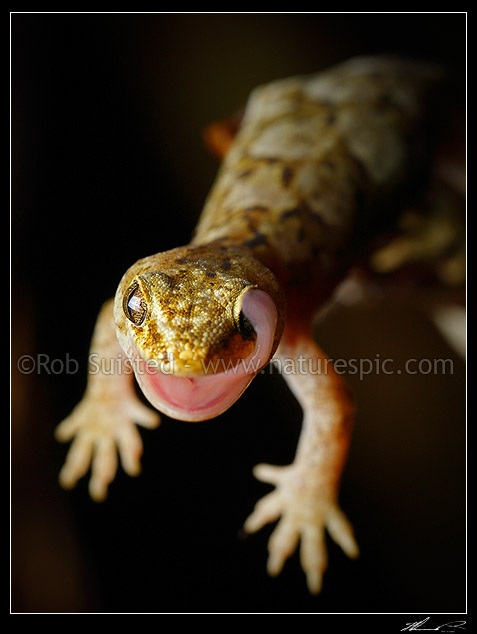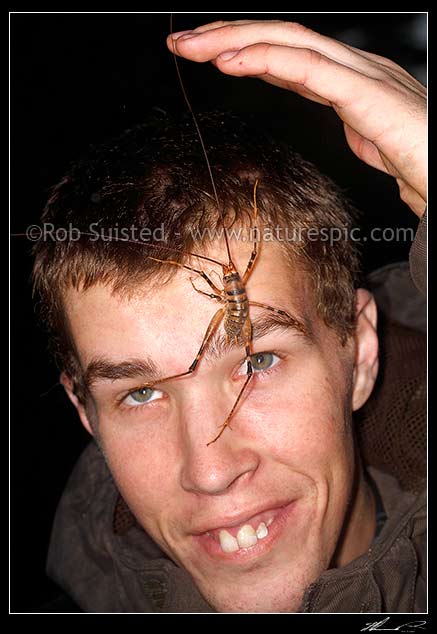‘We’d like you to mentor a ‘Young Gun’ photographer’ was James Frankham’s request from New Zealand Geographic Magazine. The ‘Young Gun’ was Spiderman Bryce – a keen young chap from Hamilton who has a penchant for bugs, especially big spiders. Bryce was super keen, and while spiders are not one of my fav critters, I’m always up for an interesting challenge, giving back to a good cause and something different.

Cook Strait Giant Weta female climbing onto Bryce's hand (Deinacrida rugosa, Stenopelmatidae). Endemic endangered New Zealand insect. Wetapunga. Island gigantism
NZ Geo magazine have just started a programme where they pair promising photographers with seasoned pros (not sure what my seasoning is yet though). We chose to take Bryce to Mana Island, a Scientific Reserve that is an island sanctuary for some of New Zealand’s rarest animals and plants. Currently Mana is being restored to a pest free island status, which means that the lack of introduced predators gives the local fauna a chance to recover – especially the giant weta and lizards. Kindly supported by the Department of Conservation (DOC), we were collected in the DOC boat and whisked across to Mana Island from Paremata.

Party trick. A common Gecko licking its eyeball while hanging off branch hunting at night (Hoplodactylus maculatus, Gekkonidae)
We spent the day checking out Brown Teal, Kakarikiand other creatures (not to mention the volunteer creatures planting trees for DOC) on the before the rain arrived. Sue and Frank, the DOC Rangers on Mana, were very accommodating, pointing us in the right direction to find species and things of interest. Frank took us to a known spot to look for McGregor’s Skink, one of the rarest Skinks in the world. Our luck was in, finding several of these beautiful lizards as the rain set in proper….. MORE…

Defiance - a rare McGregor's skink stands up to scrutiny (Oligosoma macgregori previously known as Cyclodina macgregori). Very rare NZ endemic endangered species

LOVE this shot! The rare McGregor's skink with raindrops on head (Oligosoma macgregori, Scincidae). Previously known as: Cyclodina macgregori. Very rare NZ endemic endangered species
Bryce was super keen and a quick learner. He’d done a bit of photography (especially invertebrate macro) but had never been out with someone who makes their living from shooting photos. He was a fast learner and always managed to add extra bits or ideas to suggestions I’d made. One important aspect for him was to start looking for situations in his photography that lifted his images above what everyone else can get, such as the gecko image above, e.g. waiting and being ready for something unexpected like the gecko suddenly licking it’s eyeball in the shot above lifts a shot above the ordinary. We also discussed intellectual property and the need to look after it if you’ve put special creative efforts in.
Always keen to poke his nose under a rotting log or the leaf litter, Bryce was great at finding big insects and spiders to film. His eyes were continually popping out of his head, as this was his first time meeting many of our large species, Weta especially, and his first trip to a protected ecosystem such as this. The giant wetas are an example of ‘island gigantism’ and are amongst the largest and heaviest insects in the world.
After dinner while most folks back home would have been putting their feet up in front of the fire, we donned wet weather gear and set off on a wet windy nocturnal trek across the island in search of the large Flax Weevil. A real character – very cute looking, very timid and rare. They only come out at night and care must be taken when approaching…if frightened they simply fold their legs in which makes their body much like an orange pip that slides immediately off the smooth shiny flax leaves, to fall into the safety of the plant base below. With gentle respect for this guy we were able to get some nice shots.

Super cute insect - the rare Giant Flax Weevil (Anagotus fairburni), rare threatened NZ endemic insect species
Our wet nocturnal jaunt turned up some interesting other critters – like the large flax-veined slug, a beautiful native species that is decimated by rats on the mainland of NZ.
Just before our time to depart the island and get Bryce back to the airport, we had a fossick around for Bryce’s speciality – spiders. The first ‘honey’ he found was the Tunnel-web spider below. Now, I’m always keen to keep away from these, but here it was Bryce’s turn to mentor me – and it wasn’t long before I had her sitting on my hand (“I wouldn’t do this if it was bigger” he tells me during…..), before getting a few shots. An interesting aside, a few years back, New Line Cinemas and Peter Jackson licensed one of my images of the New Zealand tunnel web spiderand it was used by Hollywood to create Shelob spider in Lord of the Rings.

Black tunnelweb spider female (Porrhothele antipodiana, Hexathelidae). NZ endemic. Tunnel-web, tunnel web
A major feature of Mana Island is it’s large wetas. Weta is the generic Maori name for NZ’s endemic large cricket like insects. New Zealand broke away early from Gondwana Land and evolved with few mammal species. The island ecology caused a plethora of birds and insects to fill most niches. Hence the large herbivorous weta. Below is a male Cook Strait Weta, his large girlfriend (yes, she is nearly twice his size) is being gently fondled and caressed by Bryce in the photo at the top of this blog.

Cook Strait Giant Weta male (Deinacrida rugosa, Stenopelmatidae). Endemic endangered New Zealand insect. Wetapunga. Island gigantism, Mana Island, New Zealand
Next, the native Cave Weta, more a large cricket, but a distant cousin to the weta above. As you can see, also very large with magnificent antennae used for sensory investigation of it’s environment – much better than eyes in the dark cave. Bryce just couldn’t wait to get to get close to this baby as you’ll see below!

Large Cave Weta climbing on Bryce's face (Gymnoplectron species, Rhaphidophoridae), SpidermanBryce, Mana Island, NZ
So, all in all a great trip that we both enjoyed. More details in the magazine later. I can report though that contrary to popular belief, giant wetas DO bite. Infact Bryce managed to get bitten by most of the creatures we met close up, except the Teal – that’s one you’d want to avoid I reckon. They look cute and small, but after filming them taking on Paradise ducks over twice their size you’d know what I meant – especially as they’d come in low and fast!

Looking north from Makara to Mana Island and Kapiti Island (behind) on a sunny day, Wellington District, New Zealand
Please make sure you purchase the next issue of New Zealand Geographic, or even better, subscribe to this august journal. It will help James support more initiatives like this.
Also, very special thanks to Sue Caldwell and Frank Higgott on Mana, and to Lisa Clapcott at Waikanae for being so enthusiastic in their support. Bryce, thanks for your good company – hope to see more of you in future.
Technical specs for you gear freaks out there: These shots were taken on the Canon 1Ds Mark3, with a range of lenses, mainly the EOS 100mm f2.8 macro, EOS 65mm f2.8 MP-E macro, EOS 14mm f2.8 L being mostly used on this shoot. Good lighting for macro is vital, and in the field it’s tough (and more so when it’s raining), you often have to wing it with what you have. Good soft light is normally the key, but sometimes you want to poke a bit of high contrast light into to make things a bit more dramatic. I use the Canon twin head flash (Macro Twin Lite MT-24EX) a lot but it can be a bit harsh so I often swap it out with a mini soft box set up and multiple flashes driven by the Speedlite Transmitter ST-E2.
















Joe copied this link to his blog to share with others: [...] Very rare creepy-crawlies. Mentoring a young photog for NZ Geo Mag; This entry was written by JoE, posted on June 15, 2009 at 12:59 am, filed under general and [...]
Thanks Joe, you obviously found the blog post informative – thanks for sharing it. Rob
Hi Rob,
I’ve had some contact with Bryce through Flickr & email.
He’s a very talented young man.
I think its great that he guys at NZ Geo have taken him on….wish it were me
I’ve been taking NZ native macros fort a few years now & have just got the Canon SX IS which I’m looking forward to using with my Raynox DCR 150
Just exploring focus stacking too,which opens up a whole new world.
A great blog.
You guys keep up the good work.
Cheers
Steve
Hi Steve
Thanks for the comments.
It was good to work with NZ Geographic Magazine, Bryce and DOC – a great outcome for all I think. Macro is wonderful.
Hey, check back in a week or so – just done an amazing shoot on native NZ falcons – it blew me away.
Cheers
Rob
Excellent post, I’ve also been following Bryce’s work through flickr and ones he has sent me directly. Talented both of you.
That MP-E 65 sure has a shallow DOF.
Keep it up
Warren
Hey Rob
Brilliant blog, amazing read! You just had to stick the second to last shot in didn’t you!!! How did the shot of the Geko biting my finger turn out?
Spidermanbryce
Hi Warren, thanks for the feedback and kind comments. Enjoyed the mentoring with Bryce. Yes, the MP-E is a tough one to get used to, but worth perservering with I think. All the best
Rob
Hi Bryce, pleased you enjoyed the blog, as much as you loved having the bugs on your face! I just had to because you were in heaven! Just processed the Gecko shot yesterday, so here it is . I hope your wound has mended, and the tears have dried. Cheers Rob
Hey Rob
Awesome shot, cheeky gecko!
Cheers
Bryce
I really enjoy the blog article.Thanks Again.
Great Post, thanks for the fine Post
Hello, me and boys caught very huge bug, dunno what it called. Which best website to find out what kind bug this is and is it rare? Maybe I email you photo?
Awesome post! I was looking up Weta and saw the picture of Bryce who was in art class with me at high school. Even then he was a ‘spiderman’, drawing epic spider pictures and (to my slight horror) bringing in spiders he had captured. Awesome guy, so happy that he is doing what he loves!